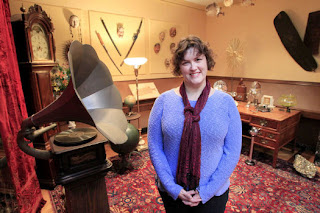KC Fringe Festival producer/director writes the plot, museum supplies the setting.
by Alice Thorson, Kansas City Star, Nov 23, 2012.
It could be a hit. Or it could be a big flop.
In any event, a new exhibit at the Nelson-Atkins Museum of Art pushes well beyond the museum’s comfort zone in a bid to attract visitors in the 20- to 40-year-old range.
The show, “The Magnificent Collection of Gilbert G. Hargrove,” was not put together in the conventional, objects-first, way. Banking on her reputation for successful productions at the Kansas City Fringe Festival, the museum invited producer/director Tara Varney, 43, to invent a story that would define a show.
Varney’s latest project at Fringe was a play titled “Sexing Hitler,” based on true accounts of Nazi soldiers being given inflatable sex dolls to keep them away from prostitutes. For the Nelson, she conceived a story of a fictional 19th-century adventurer who traveled the world collecting things that he donated to the Nelson in the 1930s.
The exhibit presents the fictional Hargrove’s “gift” in a small gallery that has been transformed into a study and anteroom setting, with a Persian carpet on the floor, a desk outfitted with period objects, and cases and wall displays filled with Japanese drama masks, snuff bottles, a Chinese cloissonné altar set, paintings on clam shells, weapons and a bear claw necklace.
Given the 1930s timing, a visitor could imagine that Hargrove is an alter-ego of William Rockhill Nelson, who left land and money to build the museum. Well, not exactly. More likely, Hargrove could be considered the incarnation of the many collectors who have donated their motley treasures to the Nelson over the years.
Tinged with 19th-century notions of the exotic, the exhibit is a veritable flea market of collectibles from faraway places and American Indian cultures pulled from the drawers and shelves of museum storage.
Leesa Fanning, who connected the curators whose departments contributed objects to the show, characterizes the exhibit as a cabinet of curiosities — a collection of odd and wondrous things. (An ongoing exhibit in the Bloch Building photography galleries also explores the cabinet of curiosities theme).
In 2005, the Walters Art Museum in Baltimore added a “Chamber of Wonders” to its baroque and Renaissance installation. The display, which is based on what a 17th-century nobleman in the southern Netherlands might have collected, features art and natural history objects, including paintings and sculpture, taxidermy animals, scarabs, nose rings and other artifacts from the museum’s archives.
A week before the Nov. 23 opening of the Hargrove show, Fanning and the rest of the team who collaborated on it were thinking on the fly. Conservator Scott Heffley, a collector himself who contributed many of the objects that appear in Hargrove’s study, including a trio of suspended puffer fish, had brought in more objects from his home that morning.
“I collect folk art and strange things,” he explained. “Art Deco, crystal balls, crystals. This is the tip of the iceberg.” Over the weekend Heffley was headed to a big antiques show in New York, raising the possibility of further contributions to Hargrove’s trove.

Head of conservation Elisabeth Batchelor and Amber Mills, the designer who transformed the small gallery in the southwest corner of the Nelson-Atkins building into a space for Hargrove’s booty, were getting ready to situate the many objects yet to come up from museum storage.
Project coordinator Rose May was settling details and continuing her conversations with Varney, who will give three performances in the role of Hargrove’s great-granddaughter in the exhibit space, beginning in December.
For her part, Varney, with her partner Bryan Colley, was completing biographies of six generations of Hargroves that will form the exhibit’s backstory.
“There’s an art collector, a dealer, an activist, an authenticator and a forger,” she said.
During the exhibit, Varney will put up a Facebook page for her Tara Hargrove character, “so the character and all the stories can be continued outside of the space.”
“The Magnificent Collection of Gilbert C. Hargrove” is the latest manifestation of Nelson-Atkins director Julián Zugazagoitia’s determination to think outside the box when it comes to connecting the museum with the community.
The Nelson is not alone in this effort. It was one of five museums whose directors formed a consortium at last winter’s American Association of Museum Directors conference, where they decided to engage the services of the Innovatrium, an innovation laboratory in Ann Arbor, Mich.
Last spring the Nelson, the High Museum of Art in Atlanta, the Minneapolis Institute of Arts, the Toledo Museum of Art and the Carnegie Museums in Pittsburgh sent five staff members each to a two-day boot camp at the Innovatrium. One idea that came up, May said, was to create a great story on the model of independent film as the basis for an exhibit.
“Julián has been talking a lot about how we have the opportunity to tell great stories at the museum and encouraging us to tell stories,” she said.
This show builds on that approach.
“It changes the way we typically do things,” May said. “It starts with a great story and then we find the objects.”
“For us, it’s very upside down,” Batchelor added.
The storytelling aspect isn’t the only part of the show that departs from curatorial norms.
This is a show that came together at lightning speed for a museum that typically spends months and years in preparation.
“We didn’t fill out any forms,” Fanning said. “It was a lot of fun.”



No comments:
Post a Comment